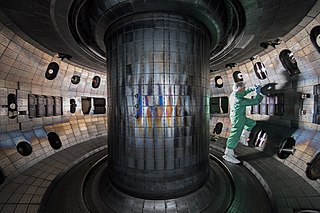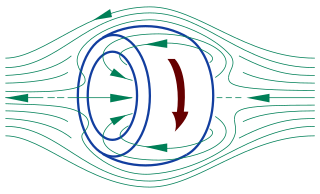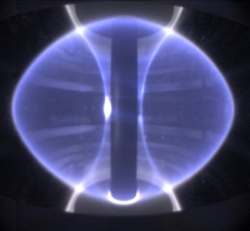Related Research Articles

A stellarator confines plasma using external magnets. Scientists aim to use stellarators to generate fusion power. It is one of many types of magnetic confinement fusion devices, most commonly tokamak. The name "stellarator" refers to stars because fusion mostly occurs in stars such as the Sun. It is one of the earliest human-designed fusion power devices.

A tokamak is a device which uses a powerful magnetic field generated by external magnets to confine plasma in the shape of an axially symmetrical torus. The tokamak is one of several types of magnetic confinement devices being developed to produce controlled thermonuclear fusion power. The tokamak concept is currently one of the leading candidates for a practical fusion reactor.

A reversed-field pinch (RFP) is a device used to produce and contain near-thermonuclear plasmas. It is a toroidal pinch that uses a unique magnetic field configuration as a scheme to magnetically confine a plasma, primarily to study magnetic confinement fusion. Its magnetic geometry is somewhat different from that of a tokamak. As one moves out radially, the portion of the magnetic field pointing toroidally reverses its direction, giving rise to the term reversed field. This configuration can be sustained with comparatively lower fields than that of a tokamak of similar power density. One of the disadvantages of this configuration is that it tends to be more susceptible to non-linear effects and turbulence. This makes it a useful system for studying non-ideal (resistive) magnetohydrodynamics. RFPs are also used in studying astrophysical plasmas, which share many common features.

The T-15 is a Russian nuclear fusion research reactor located at the Kurchatov Institute, which is based on the (Soviet-invented) tokamak design. It was the first industrial prototype fusion reactor to use superconducting magnets to control the plasma. These enormous superconducting magnets confined the plasma the reactor produced, but failed to sustain it for more than just a few seconds. Despite not being immediately applicable, this new technological advancement proved to the USSR that they were on the right path. In the original shape, a toroidal chamber design, it had a major radius of 2.43 m and minor radius 0.7 m.

A field-reversed configuration (FRC) is a type of plasma device studied as a means of producing nuclear fusion. It confines a plasma on closed magnetic field lines without a central penetration. In an FRC, the plasma has the form of a self-stable torus, similar to a smoke ring.

Alcator C-Mod was a tokamak that operated between 1991 and 2016 at the Massachusetts Institute of Technology (MIT) Plasma Science and Fusion Center (PSFC). Notable for its high toroidal magnetic field, Alcator C-Mod holds the world record for volume averaged plasma pressure in a magnetically confined fusion device. Until its shutdown in 2016, it was one of the major fusion research facilities in the United States.

The National Spherical Torus Experiment (NSTX) is a magnetic fusion device based on the spherical tokamak concept. It was constructed by the Princeton Plasma Physics Laboratory (PPPL) in collaboration with the Oak Ridge National Laboratory, Columbia University, and the University of Washington at Seattle. It entered service in 1999. In 2012 it was shut down as part of an upgrade program and became NSTX-U, U for Upgrade.
The Plasma Physics Laboratory at the University of Saskatchewan was established in 1959 by H. M. Skarsgard. Early work centered on research with a Betatron.

The KSTAR is a magnetic fusion device at the Korea Institute of Fusion Energy in Daejeon, South Korea. It is intended to study aspects of magnetic fusion energy that will be pertinent to the ITER fusion project as part of that country's contribution to the ITER effort. The project was approved in 1995, but construction was delayed by the East Asian financial crisis, which weakened the South Korean economy considerably; however, the project's construction phase was completed on September 14, 2007. The first plasma was achieved in June 2008.
The Enormous Toroidal Plasma Device (ETPD) is an experimental physics device housed at the Basic Plasma Science Facility at University of California, Los Angeles (UCLA). It previously operated as the Electric Tokamak (ET) between 1999 and 2006 and was noted for being the world's largest tokamak before being decommissioned due to the lack of support and funding. The machine was renamed to ETPD in 2009. At present, the machine is undergoing upgrades to be re-purposed into a general laboratory for experimental plasma physics research.

ASDEX Upgrade is a divertor tokamak at the Max-Planck-Institut für Plasmaphysik, Garching that went into operation in 1991. At present, it is Germany's second largest fusion experiment after stellarator Wendelstein 7-X.
The beta of a plasma, symbolized by β, is the ratio of the plasma pressure (p = nkBT) to the magnetic pressure (pmag = B2/2μ0). The term is commonly used in studies of the Sun and Earth's magnetic field, and in the field of fusion power designs.

The WEST, or Tungsten Environment in Steady-state Tokamak, is a French tokamak that originally began operating as Tore Supra after the discontinuation of TFR and of Petula. The original name came from the words torus and superconductor, as Tore Supra was for a long time the only tokamak of this size with superconducting toroidal magnets, allowing the creation of a strong permanent toroidal magnetic field. After a major upgrade to install tungsten walls and a divertor, the tokamak was renamed WEST.
The Tokamak de Fontenay-aux-Roses (TFR) was the first French tokamak, built in a research centre of the French Atomic Energy Commission (CEA) in Fontenay-aux-Roses, a commune in the southwestern suburbs of Paris. The project was spearheaded by Paul-Henri Rebut, and is sometimes jokingly referred to as the "Tokamak façon Rebut" – a pun on the name Rebut and the French word "rebut" meaning "rubbish".
ADITYA is a medium size tokamak installed at the Institute for Plasma Research in India. Its construction began in 1982, and it was commissioned in 1989. It was the first tokamak in India.

A spherical tokamak is a type of fusion power device based on the tokamak principle. It is notable for its very narrow profile, or aspect ratio. A traditional tokamak has a toroidal confinement area that gives it an overall shape similar to a donut, complete with a large hole in the middle. The spherical tokamak reduces the size of the hole as much as possible, resulting in a plasma shape that is almost spherical, often compared to a cored apple. The spherical tokamak is sometimes referred to as a spherical torus and often shortened to ST.
In plasma physics and magnetic confinement fusion, the high-confinement mode (H-mode) is a phenomenon and operating regime of enhanced confinement in toroidal plasma such as tokamaks. When the applied heating power is raised above some threshold, the plasma transitions from the low-confinement mode (L-mode) to the H-mode where the energy confinement time approximately doubles in magnitude. The H-mode was discovered by Friedrich Wagner and team in 1982 during neutral-beam heating experiments on ASDEX. It has since been reproduced in all major toroidal confinement devices, and is foreseen to be the standard operational scenario of ITER.

The Compact Toroidal Hybrid (CTH) is an experimental device at Auburn University that uses magnetic fields to confine high-temperature plasmas. CTH is a torsatron type of stellarator with an external, continuously wound helical coil that generates the bulk of the magnetic field for containing a plasma.
The Tokamak Physics Experiment (TPX) was a plasma physics experiment that was designed but not built. It was designed by an inter-organizational team in the USA led by Princeton Plasma Physics Laboratory. The experiment was designed to test theories about how Tokamaks would behave in a high-performance, steady-state regime.
References
- ↑ "Edge turbulence in ISTTOK: a multi-code fluid validation" (PDF). 2021.
- ↑ (Macintosh; Intel Mac OS X 10_15_7) AppleWebKit/537.36 (KHTML, like Gecko) Chrome/110.0.0.0 Safari/537.36 Citoid/WMF (mailto:noc@wikimedia.org)&ssu=&ssv=&ssw=&ssx=eyJ1em14IjoiN2Y5MDAwYTg4ZmIzYTctYWRlNC00NjA4LWE4NDAtN2MwN2RiNDFhMjBjMS0xNzMyNjk3Mzg5MDgyMC1hMDI2NDkwOTY1NmViMGZjMTAiLCJyZCI6ImlvcC5vcmciLCJfX3V6bWYiOiI3ZjYwMDA0OTIxYjE2Zi01ZTZmLTRjNzAtOTYxMy0xNzc3OTYwYTRkNWYxNzMyNjk3Mzg5MDgyMC1lZmQ5NDg4MWY4ZjZhNDQ4MTAifQ== "Radware Bot Manager Captcha". doi:10.1088/1361-6587/ac7ee5/meta.
{{cite journal}}: Check|url=value (help); Cite journal requires|journal=(help) - ↑ "ISTTOK (Instituto Superior Técnico TOKamak) | Fusion Energy Base". www.fusionenergybase.com. Retrieved 2024-11-27.